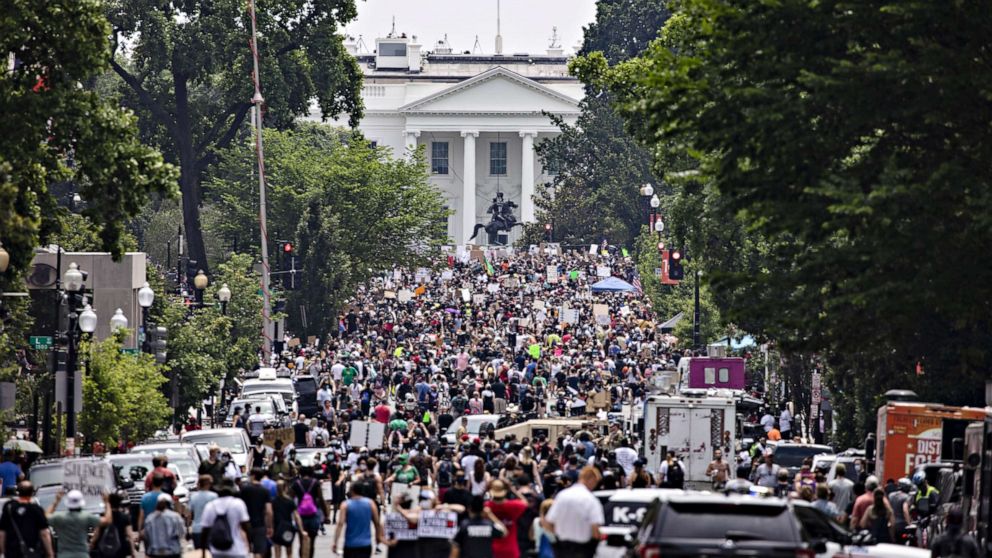It’s now official; while our attention was diverted elsewhere, Biden secured enough earned delegates to clinch the nomination. The convention will be just a formality. Last week Paul Waldman published a post titled Maybe Joe Biden isn’t such a terrible candidate after all. It’s worth reading.
The Washington Post reports that huge numbers of protesters have gathered in Washington DC and are engaged in multiple rallies in several parts of the district. I fervently wish them much success and an injury-free day. Do check out the photograph that accompanies the article, showing crowds approaching the White House from Lafayette Square Park. See the snipers on the roof of the White House? The equestrian statue is of Andrew Jackson..
Yesterday Trump was jubilant because of an unexpectedly not too awful jobs report. It turns out there was a misclassification error in the report that made the numbers look better than they are. Oops. Trump hadn’t tweeted about the error, though, when I checked.
At Vanity Fair, Eric Lutz writes that polls show Americans massively disapprove of Trump’s handling of the protests.
Two-thirds of Americans in an ABC News survey published Friday said they disapproved of the president’s handling of the response to Floyd’s killing, compared with just 32% who approve. As the Atlantic’s David Frum pointed out, it’s possible that some of those disapprove because they want Trump to be even more aggressive in his approach. But the poll suggests that it’s Trump’s authoritarian crackdown, divisiveness, and disregard for protesters’ demands that is driving the disapproval. …
… There remains a receptive audience for this ugly conception of “law and order”—it worked for Richard Nixon, Richard Daley, and countless others in the 1960s, and Trump aides are counting on it working for the president come November. But wrenching video of Floyd’s killing—as well as a spree of clips documenting outrageous, seemingly unprovoked violence by police against protesters in recent days—have made the issues at play here exceedingly difficult to deny.
The issue of the militarization and brutality of police is at the forefront now. See Jamelle Bouie, The Police Are Rioting. We Need to Talk About It.
Rioting police have driven vehicles into crowds, reproducing the assault that killed Heather Heyer in Charlottesville, Va., in 2017. They have surrounded a car, smashed the windows, tazed the occupants and dragged them out onto the ground. Clad in paramilitary gear, they have attacked elderly bystanders, pepper-sprayed cooperative protesters and shot “nonlethal” rounds directly at reporters, causing serious injuries. In Austin, Texas, a 20-year-old man is in critical condition after being shot in the head with a “less-lethal” round. Across the country, rioting police are using tear gas in quantities that threaten the health and safety of demonstrators, especially in the midst of a respiratory disease pandemic.
None of this quells disorder. Everything from the militaristic posture to the attacks themselves does more to inflame and agitate protesters than it does to calm the situation and bring order to the streets. In effect, rioting police have done as much to stoke unrest and destabilize the situation as those responsible for damaged buildings and burning cars. But where rioting protesters can be held to account for destruction and violence, rioting police have the imprimatur of the state.
We got a preview of all this after the killing of Michael Brown in Ferguson, Missouri, in 2014. At that time Joan Walsh wrote,
“This looks like a textbook case of what not to do,” Sherrilyn Ifill of the NAACP Legal Defense Fund told Lawrence O’Donnell.
On the 49th anniversary of the 1965 Watts riots in Los Angeles, it’s important to remember that the famous Kerner Commission established to look at 1960s urban upheavals found that virtually every “riot” was triggered by police brutality – and that has continued in our own time, from the so-called Rodney King riots in 1992 through today. On MSNBC Ifill indicted the failures of police training and culture that led not only to the killing of Michael Brown, but also the overreaction to every night of protests.
But Ifill also made the important point that the militarization of the Ferguson police is something entirely new and enormously disturbing. The images Wednesday night should wake all of us up to the alarming militarization of local cops all over the country. How did a local police department get tanks and trucks and body armor that look like it all was designed for the streets of Baghdad and not a little city outside St. Louis?
This is one of many issues that has been allowed to fester for too long. We need massive police reform. See also the New York Times editorial board, America’s Protests Won’t Stop Until Police Brutality Does and Charles Pierce, The Chief Vector Is the Executive Branch.
Elsewhere, in the Baby Steps department, we learn that the U.S. Marines have officially banned displays of Confederate flags, including on bumper stickers and coffee mugs, at any of their installations. Only took ’em just under 160 years.
Is there no end to the Stable Genius? Trump toured a factory that makes swabs for coronavirus testing in Maine. That’s fine, but all the swabs made while he was in the factory will have to be tossed. It’s not clear from the article whether this was done because El Dumbo’s refusal to wear a mask contaminated the product (likely) or some other reason.
Other Stuff to Read
Franklin Foer, The Atlantic, The Trump Regime Is Beginning to Topple. We can hope.
Lisa Mascaro, TPM, Joint Chiefs Of Staff Chairman Privately Reached Out To Dem Leadership This Week

